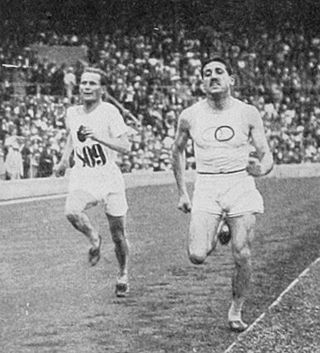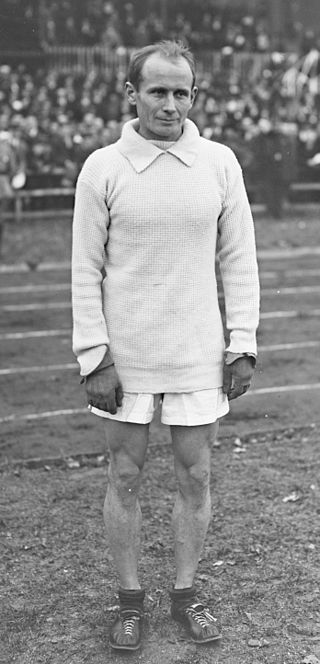
Track and field is a sport that includes athletic contests based on running, jumping, and throwing skills. The name is derived from where the sport takes place, a running track and a grass field for the throwing and some of the jumping events. Track and field is categorized under the umbrella sport of athletics, which also includes road running, cross country running and racewalking.

Charles Bennett was a British athlete, winner of the 1500 metres at the 1900 Summer Olympics and the first British track and field athlete to become Olympic champion. He was a member of Finchley Harriers which was amalgamated into Hillingdon Athletic Club in 1966.
John Thomas Rimmer was a British athlete, winner of two gold medals at the 1900 Summer Olympics. Rimmer won the AAA Championships in 4 miles (6.4 km) in 1900. He was born in Birkdale, Merseyside. With two, he jointly held the record for the most Olympic titles in athletics by a British athlete.
The men's 1500 metres was an Olympic event for the fourth time at the 1908 Summer Olympics. The competition was held on July 13, 1908, and on July 14, 1908. The races were held on a track of 536.45 metres=1⁄3 mile in circumference. The event was won by Mel Sheppard of the United States, the second consecutive Games an American had won the event. Sheppard, like Jim Lightbody in 1904, would also win the 800 metres for a middle-distance double.

The men's 2500 metres steeplechase was a track & field athletics event at the 1900 Summer Olympics in Paris. It was the first time that a steeplechase race was held at the Olympics. The race was held on July 15, 1900, on a 500-metre track. Six athletes from six nations competed in the shorter of the two steeplechase events. The 4000 metre steeplechase race was held one day later. The event was won by George Orton of Canada, the nation's first gold medal in athletics. Sidney Robinson of Great Britain took silver, while Jean Chastanié of France earned bronze.

The men's 5000 metres team race was the final track and field event on the athletics programme at the 1900 Summer Olympics in Paris. It was the first time that a team race was held at the Olympics. It was held on July 22, 1900. Two teams competed: Racing Club de France from France and Amateur Athletic Association of England from multiple nations. Each team had five athletes. The AAA team won the competition, despite Rowley being injured and unable to finish.

The men's 200 metres was a track and field athletics event held as part of the Athletics at the 1912 Summer Olympics programme. It was the fourth appearance of the event, which has appeared at every edition of the Summer Olympics since the 1900 Summer Olympics. The competition was held on July 10, 1912, and on July 11, 1912. 61 runners from 19 nations competed. NOCs could enter up to 12 athletes. The event was won by Ralph Craig of the United States, the nation's third victory in four Games. Another American, Donald Lippincott, took silver. Great Britain earned its first medal in the 200 metres with Willie Applegarth's bronze.

The men's 5000 metres was a track and field athletics event held as part of the Athletics at the 1912 Summer Olympics programme. It was the debut of the event, which along with the 10000 metre event replaced the 5 mile race held at the 1908 Summer Olympics. The competition was held on Tuesday, July 9, 1912, and on Wednesday, July 10, 1912. Thirty-one long-distance runners from eleven nations competed. NOCs could enter up to 12 athletes.
Howard Van Nostrand Valentine was an American track and field athlete.

The men's 1500 metres was a track and field athletics event held as part of the Athletics at the 1904 Summer Olympics program. It was the third time the event was held. 9 runners from 3 nations participated. The competition was held on September 3, 1904. The event was won by Jim Lightbody of the United States, completing his 1904 treble. It was the first championship in the event for the United States. The Americans, with 7 of the 9 runners, swept the medals.

The men's 2590 metres steeplechase was a track and field athletics event held as part of the Athletics at the 1904 Summer Olympics programme. It was the only time the event was held at the 2590 metre distance, though the 1900 Summer Olympics had featured a similar event in the 2500 metre steeplechase. The competition was held on August 29, 1904. 7 athletes from 2 nations competed. Jim Lightbody of the United States won the first of his three gold and four overall medals in the 1904 Games. Irishman John Daly took silver, with Lightbody's countryman Arthur L. Newton earning bronze.

The men's marathon at the 1956 Summer Olympics in Melbourne, Australia was held on Saturday December 1, 1956. There were 46 participants from 23 nations, with 13 runners not completing the race. The maximum number of athletes per nation had been set at 3 since the 1930 Olympic Congress. The event was won by Alain Mimoun of France, the nation's first Olympic marathon victory since 1928 and third overall. Yugoslavia took its first Olympic marathon medal with Franjo Mihalić's silver. Finland returned to the podium in the event for the first time since 1932 as Veikko Karvonen took bronze.
The men's 800 metres event was part of the track and field athletics programme at the 1920 Summer Olympics. The competition was held from Sunday, August 15, 1920, to Tuesday, August 17, 1920. Forty runners from 17 nations competed. No nation had more than 4 runners, suggesting the limit had been reduced from the 12 maximum in force in 1908 and 1912. The event was won by Albert Hill of Great Britain, snapping a three-Games streak of American victories and starting a four-Games streak of British wins. Bevil Rudd, the 400 metres winner in 1920, took bronze to give South Africa its first medal in the 800 metres.

The men's marathon event was part of the track and field athletics programme at the 1920 Summer Olympics. The distance of this race was 42.75 kilometres. The competition was held on Sunday, 22 August 1920. 48 runners from 17 nations competed. No nation had more than 4 runners, suggesting the limit had been reduced from the 12 maximum in force in 1908 and 1912. The event was won by Hannes Kolehmainen of Finland, the nation's first Olympic marathon medal and victory; Kolehmainen received his fourth gold medal, having won the 5000 metres, 10,000 metres, and individual cross country in 1912. Estonia and Italy also won their first marathon medals.
The men's 1500 metres event was part of the track and field athletics programme at the 1924 Summer Olympics. The competition was held on Wednesday, July 9, 1924, and on Thursday, July 10, 1924. As for all other races the track was 500 metres in circumference. Forty middle distance runners from 22 nations competed. The maximum number of athletes per nation was 4.
The men's 400 metres event was part of the track and field athletics programme at the 1924 Summer Olympics. This race was depicted in the film Chariots of Fire. The competition was held on Thursday, July 10, 1924, and on Friday, July 11, 1924.

The AAA Championships was an annual track and field competition organised by the Amateur Athletic Association of England. It was the foremost domestic athletics event in the United Kingdom during its lifetime, despite the existence of the official UK Athletics Championships organised by the then governing body for British athletics, the British Athletics Federation between 1977 and 1993, and again in 1997. It was succeeded by the British Athletics Championships, organised by the BEF's replacement/successor, UK Athletics under its brand name British Athletics.

The 400 metres at the Summer Olympics has been contested since the first edition of the multi-sport event. The men's 400 m has been present on the Olympic athletics programme since 1896 but nearly seventy years passed before the introduction of the women's 400 m, which has been held continuously since the 1964 Games. It is the most prestigious 400 m race at elite level. The competition format typically has two qualifying rounds leading to a final race between eight athletes.

Team races at the Summer Olympics were track running competitions contested at the multi-sport event from 1900 to 1924.

The WAAA Championships was an annual track and field competition organised by the Women's Amateur Athletic Association (WAAA) in England. It was the foremost domestic athletics event for women during its lifetime.












